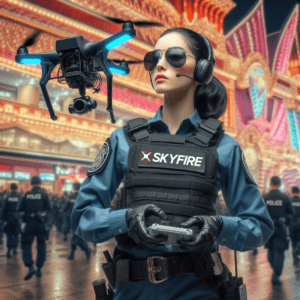
DRONELIFE is pleased to present this guest post by Matt Sloane, the Founder and CEO of Skyfire Consulting. In this piece, Matt explains just what it is like to operate security drones over a Tier 1 event. DRONELIFE neither accepts nor makes payment for guest posts. All images courtesy Skyfire.
Behind the Scenes: the Drones Providing Security at Tier 1 Events Like the Super Bowl
“Ten-thousand dollar tickets for the big game? Man, that’s cheap for a Taylor Swift concert!”
We’ve all seen the meme, and surely, aside from the commercials, the biggest chatter about this weekends’ gridiron matchup will be whether TSwift can make it to Vegas from Tokyo in time for kickoff.
To be sure, whenever she gets there, we’ll be seeing plenty of her! What you likely won’t be seeing are the drones that various law enforcement agencies may be using to help protect the big event — and those it’ll be using to help protect the big event against other drones.
Just 5 years ago (it feels like a decade in COVID-years), Skyfire had the pleasure of operating security drones for the first time ever over a Tier 1 event.
The process for getting them approved was like figuring out a foreign language – I’m guessing both for us and for the federal regulators we were dealing with.
It was a brand new process, and we all stumbled through it together. We were joined on a rooftop by our friends from CNN Air, CNN’s aerial imaging group; and though we were never close enough to see them, we heard the NFL or their television partners had one or two for cool video cutaways of Mercedes-Benz Stadium.

Our job that day — use drones to monitor the grounds surrounding the stadium, most of which belonged to the Georgia World Congress Center Authority — and report anything out of the ordinary.
While it began as a vague “overwatch” mission, it quickly became apparent how these eyes in the sky were going to be useful.
Our most requested task: guiding EMS into an area where somebody had been reported injured. With hundreds of thousands of people on site for concerts, parties, tailgates and some football game; finding access routes through the crowds could be difficult if not impossible, and having that overhead view was key.
The next most common call was for suspicious behavior reported in some far-flung area – an obvious cause for concern; followed by observing traffic flow in and out of the area and the occasional call to keep “eyes on” a motorcade of VIPs.
The one that got our juices flowing the most though, were reports of errant drones flying in the area.
Our federal law enforcement partners had, for the first time, gotten regulatory authority to use drone detection and mitigation technologies at this event, so everybody was on high alert!
With a 30-mile wide temporary flight restriction in place, and all of us who were supposed to be there attached to tethers, anything out “free-flying” stuck out like a sore thumb.
Despite numerous warnings, press conferences, email blasts to pilots and more; there were, by most estimates, 57 incursions that weekend into the TFR by drones. 56 of them were picked up by the drone detection systems in place, and number 57 would have been too, to be sure.
But one of our drone teams happened to see the operator of number 57 taking his DJI Inspire out of the case on top of a parking deck, and reported it up the chain before he even turned on the drone.
Whether various agencies are using drones at this upcoming matchup, how they’re using them or who’s at the controls, we can’t say – and that’s by design. But from my vantage point 15 stories up on a roof, overlooking Atlanta’s dance with the big game, I can say without a doubt that this technology is incredibly useful, and should be a part of the consideration for any event, big or small.
Matt is an inaugural member of the National Fire Protection Association (NFPA) technical committee on drones, a technical advisor to the International Association of Fire Chiefs technology council, and an FAA-certified pilot.
Read more from Matt Sloane:
- Skyfire Consulting’s Matt Sloane on the State of the Drone Industry: and His Predictions for 2024
- Why Now is the Time to Bet Big on Drones: a DRONELIFE Exclusive, from Matt Sloane
- ACLU Calls for Strict Limits on Police Drones. Skyfire Consulting Asked Them Why.
Miriam McNabb is the Editor-in-Chief of DRONELIFE and CEO of JobForDrones, a professional drone services marketplace, and a fascinated observer of the emerging drone industry and the regulatory environment for drones. Miriam has penned over 3,000 articles focused on the commercial drone space and is an international speaker and recognized figure in the industry. Miriam has a degree from the University of Chicago and over 20 years of experience in high tech sales and marketing for new technologies.
For drone industry consulting or writing, Email Miriam.
TWITTER:@spaldingbarker
Subscribe to DroneLife here.